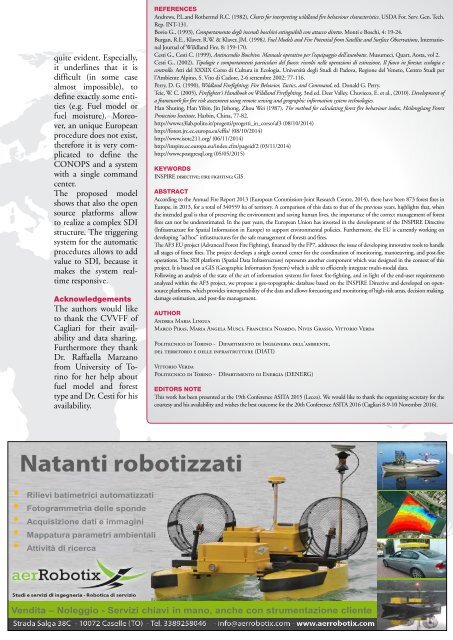GEOmedia_3_2016
La prima rivista italiana di geomatica
La prima rivista italiana di geomatica
You also want an ePaper? Increase the reach of your titles
YUMPU automatically turns print PDFs into web optimized ePapers that Google loves.
quite evident. Especially,<br />
it underlines that it is<br />
difficult (in some case<br />
almost impossible), to<br />
define exactly some entities<br />
(e.g. Fuel model or<br />
fuel moisture). Moreover,<br />
an unique European<br />
procedure does not exist,<br />
therefore it is very complicated<br />
to define the<br />
CONOPS and a system<br />
with a single command<br />
center.<br />
The proposed model<br />
shows that also the open<br />
source platforms allow<br />
to realize a complex SDI<br />
structure. The triggering<br />
system for the automatic<br />
procedures allows to add<br />
value to SDI, because it<br />
makes the system realtime<br />
responsive.<br />
Acknowledgements<br />
The authors would like<br />
to thank the CVVFF of<br />
Cagliari for their availability<br />
and data sharing.<br />
Furthermore they thank<br />
Dr. Raffaella Marzano<br />
from University of Torino<br />
for her help about<br />
fuel model and forest<br />
type and Dr. Cesti for his<br />
availability.<br />
REFERENCES<br />
Andrews, P.L.and Rothermel R.C. (1982), Charts for interpreting wildland fire behaviour characteristics. INTERGEO USDA For. Serv. Gen. Tech.<br />
Rep. INT-131.<br />
Bovio G., (1993), Comportamento degli incendi boschivi estinguibili con attacco diretto. Monti e Boschi, 4: 19-24.<br />
Burgan, R.E., Klaver, R.W. & Klaver, JM. (1998), Fuel Models and Fire Potential from Satellite and Surface Observations, International<br />
Journal of WiIdIand Fire, 8: 159-170.<br />
Cesti G., Cesti C. (1999), Antincendio Boschivo. Manuale operativo per l’equipaggio dell’autobotte. Musumeci, Quart, Aosta, vol 2.<br />
Cesti G., (2002), Tipologie e comportamenti particolari del fuoco: risvolti nelle operazioni di estinzione, Il fuoco in foresta: ecologia e<br />
controllo. Atti del XXXIX Corso di Cultura in Ecologia. Università degli Studi di Padova, Regione del Veneto, Centro Studi per<br />
l’Ambiente Alpino, S. Vito di Cadore, 2-6 settembre 2002: 77-116.<br />
Perry, D. G. (1990), Wildland Firefighting: Fire Behavior, Tactics, and Command, ed. Donald G. Perry.<br />
Teie, W. C. (2005), Firefighter’s Handbook on Wildland Firefighting, 3nd ed. Deer Valley. Chuvieco, E. et al., (2010). Development of<br />
a framework for fire risk assessment using remote sensing and geographic information system technologies.<br />
Han Shuting, Han Yibin, Jin Jizhong, Zhou Wei (1987), The method for calculating forest fire behaviour index, Heilongjiang Forest<br />
Protection Institute, Harbin, China, 77-82.<br />
http://www.s3lab.polito.it/progetti/progetti_in_corso/af3 (08/10/2014)<br />
http://forest.jrc.ec.europa.eu/effis/ (08/10/2014)<br />
http://www.isotc211.org/ (06/11/2014)<br />
http://inspire.ec.europa.eu/index.cfm/pageid/2 (03/11/2014)<br />
http://www.postgresql.org (05/05/2015)<br />
KEYWORDS<br />
INSPIRE directive; fire fighting; GIS<br />
ABSTRACT<br />
According to the Annual Fire Report 2013 (European Commission-Joint Research Centre, 2014), there have been 873 forest fires in<br />
Europe, in 2013, for a total of 340559 ha of territory. A comparison of this data to that of the previous years, highlights that, when<br />
the intended goal is that of preserving the environment and saving human lives, the importance of the correct management of forest<br />
fires can not be underestimated. In the past years, the European Union has invested in the development of the INSPIRE Directive<br />
(Infrastructure for Spatial Information in Europe) to support environmental policies. Furthermore, the EU is currently working on<br />
developing "ad hoc" infrastructures for the safe management of forests and fires.<br />
The AF3 EU project (Advanced Forest Fire Fighting), financed by the FP7, addresses the issue of developing innovative tools to handle<br />
all stages of forest fires. The project develops a single control center for the coordination of monitoring, manoeuvring, and post-fire<br />
operations. The SDI platform (Spatial Data Infrastructure) represents another component which was designed in the context of this<br />
project. It is based on a GIS (Geographic Information System) which is able to efficiently integrate multi-modal data.<br />
Following an analysis of the state of the art of information systems for forest fire-fighting, and in light of the end-user requirements<br />
analyzed within the AF3 project, we propose a geo-topographic database based on the INSPIRE Directive and developed on opensource<br />
platforms, which provides interoperability of the data and allows forecasting and monitoring of high-risk areas, decision making,<br />
damage estimation, and post-fire management.<br />
AUTHOR<br />
Andrea Maria Lingua<br />
Marco Piras, Maria Angela Musci, Francesca Noardo, Nives Grasso, Vittorio Verda<br />
Politecnico di Torino - Dipartimento di Ingegneria dell'ambiente,<br />
del territorio e delle infrastrutture (DIATI)<br />
Vittorio Verda<br />
Politecnico di Torino - DIpartimento di Energia (DENERG)<br />
EDITORS NOTE<br />
This work has been presented at the 19th Conference ASITA 2015 (Lecco). We would like to thank the organizing secretary for the<br />
courtesy and his availability and wishes the best outcome for the 20th Conference ASITA <strong>2016</strong> (Cagliari 8-9-10 November <strong>2016</strong>).<br />
• Rilievi batimetrici automatizzati<br />
• Fotogrammetria delle sponde<br />
• Acquisizione dati e immagini<br />
• Mappatura parametri ambientali<br />
• Attività di ricerca<br />
Vendita – Noleggio - Servizi chiavi in mano, anche con strumentazione cliente<br />
Special Supplement to <strong>GEOmedia</strong> Journal Issue n°3-<strong>2016</strong> 31


















